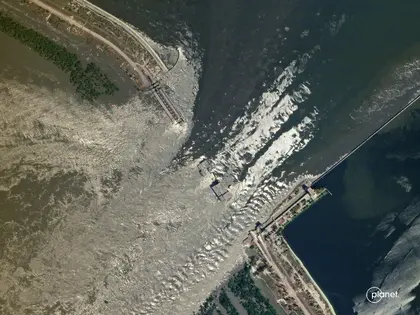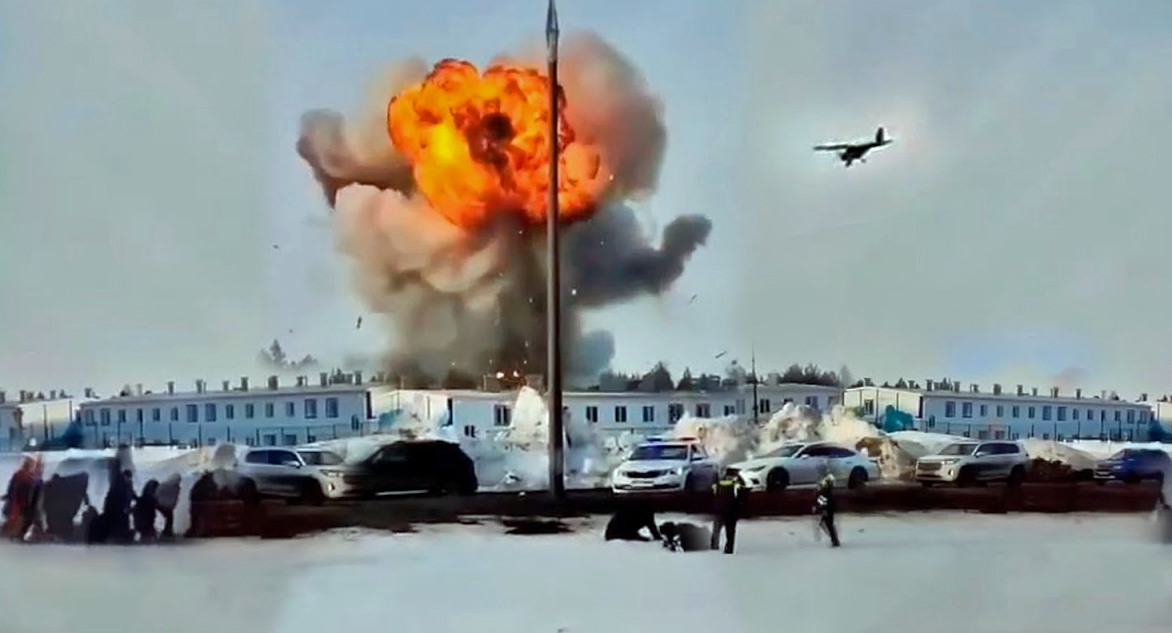A senior Ukrainian general only hours after the Kakhovka dam was destroyed said that as far as official Kyiv is concerned the power station’s destruction would not significantly affect plans for a counteroffensive. But elsewhere the jury on that is definitely still out.
General Serhiy Nayev, commander of the Armed Forces of Ukraine (AFU) Joint Forces Command, in late Tuesday comments to the UNIAN news agency said the Ukrainian military knew Russian detonation of the dam was possible, and that contingency plans were in place to deal with it. The Kakhovka hydroelectric station’s destruction was a disaster and a war crime, but from the military point of view the AFU will keep to the plan, he said.
JOIN US ON TELEGRAM
Follow our coverage of the war on the @Kyivpost_official.
Opinions among pundits and observers – on both sides of the war – were more mixed. Most observers said the dam’s destruction helped out Russia temporarily, but views were split on which side gained more overall. Many pointed out that the basic military problem for the Russian army along the Dnipro River front – lack of troops – isn’t going anywhere.
Advantages to Russia
A Kremlin strategy from the outset of the war has been to terrorize Ukrainian civilians and destroy Ukrainian civilian infrastructure. Destruction of the Kakhovka dam advances that strategy.
The Kakhovka hydroelectric station is, historically, a key power source for Ukrainian heavy industry in Zaporizhzhia and Krivoi Rih, and that region’s other main power source – the Zaporizhzhia nuclear power plant, in adjacent Enerhodar – is directly dependent on steady and controlled flow in the Dnipro, for reactor cooling.

Ukrainian Drone Reportedly Strikes Russian-Seized Ship in Crimea
The dam’s destruction has, according to some media reports, cut Ukraine’s national industrial electricity generation capacity by one-quarter, for years. That shortfall will probably last well beyond any likely end to the war, allowing Kremlin diplomats again, to argue to European diplomats that the war in Ukraine is so destructive that Kyiv must be forced to make concessions, to end the destruction.
Armed Forces of Ukraine cross-river amphibious attacks were en train [ongoing – ed.] and the dam’s demolition forestalled those attacks.
Ukrainian military media since mid-April has reported the presence of small Ukrainian army units operating and raiding on the left bank of the Dnipro River, particularly in its lower reaches, a half-dozen marshy islands scattered between the river’s shores, and on the Kinburn Spit, a peninsula sticking out into the Black Sea near the river’s mouth.
According to the volunteer-operated War in Ukraine information platform, a primary reason for the Russian demolition of the Kakhovka dam was because Armed Forces of Ukraine (AFU) units in late May had started grabbing small boats and rivercraft in the Kherson sector, and in some cases were seen to be training in amphibious operations and assault landings.
Destruction of the dam triggered a wall of high water that small craft would not be able to negotiate until the flood surge subsides, and at the same time, created tens of thousands of civilian refugees the Ukrainian government had to take care of, in the exact location where the Ukrainian army was planning an over-water assault. Neither of these accrued advantages will be permanent, the platform said in a June 6 webcast.
“Ukraine had several small bridgeheads as of the end of April and they still had them, and they were actively massing a fleet of small boats to land troops, close to a brigade, and it was imminent. The problem for the Russian side is that they did not have troops and they did not know where it was going to happen…” the report said.
“They [Russia by destroying the dam] bought 3-10 days. In desperation you do desperate things.”
Blowing up the dam created a more difficult, not easier, obstacle for the Ukrainian army to cross.
Once the water surge subsides the Dnipro River valley will likely revert to a more natural state: a wide, open extensive wetland with plenty of standing water and few hard roads. The waterway and the land draining it, officials from Ukraine’s Ministry of Emergency Situations are predicting, will still be there, it will just be shallower and, because the dam will no longer be controlling surges, more likely to be flooded in places.
In the relatively early days of the war, in May 2022, the AFU won a series of victories in the south-eastern Luhansk region, using for the first time massed, drone-controlled artillery to break up and destroy another army’s attempt to cross a river. The battles took place near the town Bilohorivka in heavily wooded terrain that, in past wars, would have mostly concealed a force trying to cross a waterway.
In the case of the Siviersky Donets River battles, drones and hundreds of very recently-delivered NATO artillery pieces changed that equation. The Russian army attempted to cross the Siviersky Donets at least six times, but accurate artillery strikes demolished the assaults.
A year later, the Ukrainian army now faces a similar task but with more complications: the Dnipro is wider and deeper than the Siversky Donets, the terrain around the Dnipro River is mostly steppe and wide open, and in June 2023 both sides’ armies have had more than a year to battlefield practice using drones to mass artillery fires.
Advantages to Ukraine
Russia’s riverside trenches and minefields were literally washed away.
The Russian military has concentrated its main battle forces outside the Kherson sector, relying on the Dnipro River and fortifications at possible crossing points, and small numbers of troops, to deter Ukrainian attack.
The geography of the lower Dnipro River valley pushes excess water predominantly onto land on the flatter, left bank, so when the Kakhovka dam was breached the Russian frontline defensive belt was deluged. In some places, Russian troops had to evacuate in water up to their waists, and at other locations land mines floated free from defense lines to drift downriver.
It’s not clear how much ammunition and equipment were lost in the withdrawal as well, but, the Kremlin’s new Kherson sector defensive belt, further inland, will almost certainly be less developed and prepared than the one Russia’s soldiers just abandoned.
Flooding the Dnipro valley was a card the Russian army could only play once, and it did.
Russian occupying authorities in the months prior to the dam’s demolition had held water upstream to maximum levels, according to most analysts specifically to have the option of releasing a mass of water downstream and nullifying Ukrainian attempts to cross the river. With the dam now destroyed, the flood surge already is falling and in the coming weeks and months water levels in the Dnipro will be, observers said, relatively low and predictable throughout its entire lower reaches.
The Ukrainian military has bridging equipment and has been practicing with it. According to some military information platforms like the pro-Russia Readkovka, all in all, the Dnipro River now is much less of a barrier to a Ukrainian river crossing operation than it was on Monday.
A wide flood plan with plenty of marshes and few roads cuts both ways, now it will be much harder for Russian troops to concentrate anywhere in defense along the river line, and the Ukrainians will exploit that if possible.
All observers agree that the key problem faced by the Russian military, across the front, is shortages of battle-worthy troops and sufficient weapons and ammunition, and that the main benefit of the Dnipro River line to Russian defenses was that the river barrier allowed Moscow to economize forces in the Kherson sector, for use elsewhere.
According to Kremlin gadfly Igor Girkin, a former intelligence operative who led Russian troops and volunteers during Russia’s first invasion of Donbas in 2014, the detonation of the Kakhovka dam and removal of its ability to control downstream flow, will make the river’s floodplain a soggy, difficult-to-maneuver place where the Russian army has no hope of holding a continuous perimeter with ground forces.
The AFU will inevitably seek out points where the Russian army is weak and exploit the maze of canals and waterways in the Dnipro delta not just to conduct raids but, potentially, full-dress troop landings on the Kinburn Spit in the Black Sea.
An amphibious landing like that is now easier for the AFU because, Girkin said, where once the Russian army had a relatively deep river with a few obvious crossing points usable for major assaults between itself and the AFU, now the Russian military must defend a 100-kilometer stretch of marsh and wetland, crossable at practically any place the Russians can place troops in the Ukrainians’ path.
You can also highlight the text and press Ctrl + Enter









